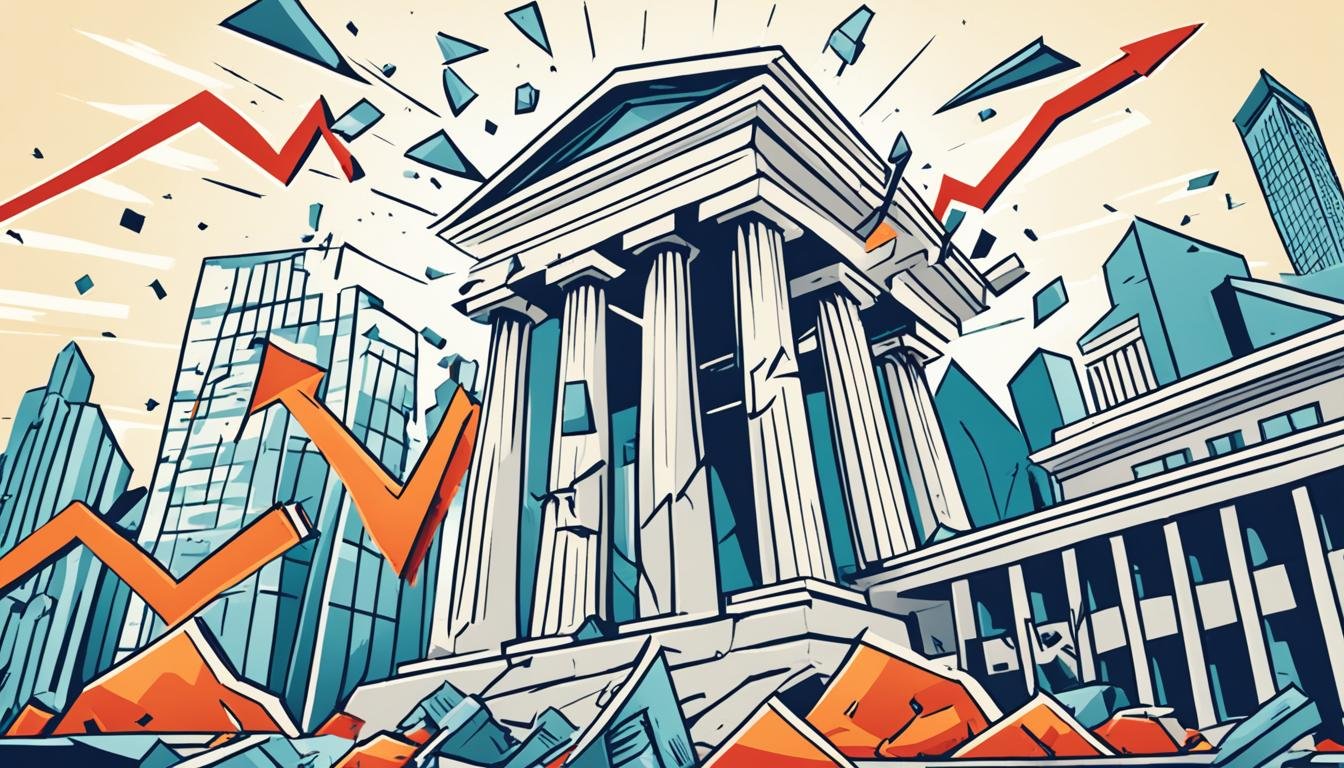Countrywide Financial: A Case Study in the Mortgage Crisis
Countrywide Financial, once the largest provider of home loans in the United States, was at the center of the mortgage crisis that led to the financial collapse and housing market crash of 2008. The company’s risky lending practices and predatory tactics played a significant role in the broader banking crisis that shook the economy.
Key Takeaways:
- Countrywide Financial was a major player in the mortgage industry and originated one in six U.S. loans.
- Subprime lending and the goal of providing affordable home loans to low-income and minority borrowers drove Countrywide’s rapid growth.
- The company’s reliance on subprime loans and risky lending practices ultimately led to its downfall.
- Angelo Mozilo, co-founder and CEO of Countrywide Financial, faced charges of securities fraud and insider trading.
- The mortgage crisis had a devastating impact on homeowners, borrowers, and the overall economy.
The Rise of Subprime Lending
Countrywide Financial’s success was built on its subprime lending practices. The company created programs like “House America” and “We House America” to enable more consumers, including minorities and lower-income individuals, to qualify for home loans and make smaller down payments.
By the early 2000s, subprime loans became a driving force behind Countrywide’s rapid growth and success in the home loans market. These loans, designed for borrowers with lower credit scores or limited financial resources, opened up homeownership opportunities for individuals who would have otherwise been unable to afford a home.
However, the overreliance on subprime loans ultimately proved to be a major downfall for Countrywide Financial. As the housing market experienced a crash and defaults on subprime loans surged, the company found itself at the center of the mortgage crisis, which had far-reaching consequences for the securities market and the economy as a whole.
Key Features of Subprime Lending Programs
| Program Name | Key Features |
|---|---|
| House America |
|
| We House America |
|
These subprime lending programs provided opportunities for marginalized communities to enter the housing market, but they also exposed borrowers to substantial financial risks. When housing prices declined and interest rates increased, many individuals struggled to keep up with their monthly payments, leading to a surge in foreclosures and financial distress.
Subprime lending offered a pathway to homeownership for many individuals who were previously excluded from traditional mortgage options. However, the rapid rise of subprime lending and the associated risks contributed to the housing market crash and subsequent financial crisis.
Understanding Subprime Loans
Subprime loans are higher-risk loans offered to borrowers who do not qualify for traditional loans. These loans are characterized by higher interest rates and various payment structures.
One type of subprime loan is an interest-only mortgage. With this type of loan, borrowers are only required to pay the interest for a specified period of time, typically 5 to 10 years. Monthly payments during the interest-only period are lower compared to a fully amortizing loan where both principal and interest are paid. However, once the interest-only period ends, borrowers must begin making monthly payments towards both principal and interest, resulting in higher monthly payments.
Another type of subprime loan is a mortgage with a fixed interest rate that converts to a variable rate after a certain period. These loans typically have a fixed rate for the first few years, typically 3 to 7 years, and then adjust periodically based on market conditions. The initial fixed interest rate provides borrowers with stability and predictable monthly payments. However, once the fixed rate period ends, the interest rate can increase, resulting in higher monthly payments.
In addition to interest-only mortgages and fixed interest rate loans, subprime loans may also include adjustable rate mortgages (ARMs) and balloon payments. Adjustable rate mortgages have interest rates that can fluctuate over time based on market conditions, leading to potential changes in monthly payments. Balloon payments, on the other hand, require borrowers to make smaller monthly payments for a specified period, often 5 to 7 years, before making a larger lump sum payment to fully repay the loan.
“Subprime loans offered borrowers with lower credit scores or limited financial resources an opportunity to become homeowners. However, the riskier nature of these loans made them vulnerable to financial challenges when housing prices dropped and interest rates increased.”
Understanding Subprime Loan Structures:
| Loan Type | Key Features |
|---|---|
| Interest-Only Mortgage | Borrowers only pay the interest for a set period of time, resulting in lower monthly payments initially. Once the interest-only period ends, borrowers must start making payments towards both principal and interest. |
| Fixed Interest Rate Loan | The loan has a fixed interest rate for the first few years, providing stability and predictable monthly payments. After the fixed rate period ends, the interest rate can adjust, potentially leading to higher payments. |
| Adjustable Rate Mortgage | The interest rate on the loan adjusts periodically based on market conditions. This can result in changes to monthly payments throughout the life of the loan. |
| Balloon Payment | Borrowers make smaller monthly payments for a specified period before needing to make a larger lump sum payment to fully repay the loan. |
Subprime loans were popular during the housing boom of the early to mid-2000s, as they provided access to homeownership for individuals who may not have qualified for traditional loans. However, when housing prices fell and interest rates increased, many borrowers found themselves unable to make their payments, leading to a wave of defaults and foreclosures.
The Subprime Crisis
The subprime mortgage crisis of 2008 had far-reaching consequences, exacerbating the broader financial crisis and leading to a global economic downturn. This section delves into the impact of the crisis, including skyrocketing foreclosure rates, bank failures, and mortgage defaults.
Foreclosure Rates
One of the most significant repercussions of the subprime crisis was the staggering increase in foreclosure rates. As borrowers struggled to meet their mortgage obligations, homes were repossessed by lenders, causing immense financial distress for countless individuals and families.
Bank Failures
The subprime crisis also resulted in a wave of bank failures. Financial institutions that had heavily invested in subprime mortgages faced significant losses as defaults surged, leading to their collapse. This further destabilized the already fragile financial system, exacerbating the crisis.
Mortgage Defaults
Mortgage defaults were a direct consequence of the high-risk lending practices prevalent during the subprime crisis. Many borrowers found themselves unable to make their monthly mortgage payments, primarily due to the increasing interest rates and infeasible payment structures attached to their subprime loans.
According to a report by the Mortgage Bankers Association, the delinquency rate for subprime mortgages reached 20.05% in the fourth quarter of 2008, a staggering increase from the 7.57% delinquency rate just a year earlier.
The combined effects of skyrocketing foreclosure rates, bank failures, and mortgage defaults propelled the subprime crisis into a full-blown financial catastrophe. This crisis reverberated through various industries, causing widespread damage and ultimately contributing to the global financial crisis.
Angelo Mozilo and the Downfall of Countrywide Financial
Angelo Mozilo, co-founder and CEO of Countrywide Financial, played a pivotal role in the company’s eventual downfall. While publicly praising the company’s subprime lending practices, Mozilo privately expressed concerns about the quality of loans and observed a lack of compliance within the origination system. Sadly, Countrywide engaged in predatory lending, targeting and overcharging African-American and Hispanic homebuyers.
Due to their unethical and risky lending practices, Countrywide became embroiled in allegations of mortgage fraud. Mozilo himself faced charges of securities fraud and insider trading, but eventually settled with the SEC in 2010. The fallout from the scandal was severe, leading to the distressed sale of Countrywide to Bank of America, which acquired the troubled company for a mere fraction of its original value.
“Angelo Mozilo played a key role in the collapse of Countrywide Financial, overseeing a culture of predatory lending and contributing to the broader subprime mortgage crisis.”
To understand the magnitude of Mozilo’s impact, it is necessary to recognize the repercussions of Countrywide’s actions. By engaging in predatory lending, Countrywide not only undermined the financial stability of countless homeowners but also contributed significantly to the overall mortgage crisis. The consequences of their actions were far-reaching, with devastating effects on the housing market and subsequent economic downturn.
To gain a clearer perspective on the downfall of Countrywide Financial, the following table provides an overview of the company’s predatory lending practices and Mozilo’s involvement:
| Predatory Lending Practices by Countrywide Financial | Angelo Mozilo’s Involvement |
|---|---|
| Overcharging African-American and Hispanic homebuyers | Expressed concerns about loan quality and compliance privately |
| Engaged in mortgage fraud | Faced charges of securities fraud and insider trading |
| Sold subprime loans to borrowers who did not qualify for traditional mortgages | Settled with the SEC in 2010 |
This image visually represents the devastating impact of predatory lending practices within the mortgage industry, shedding light on the role played by individuals like Angelo Mozilo in the financial collapse.
Angelo Mozilo’s actions and the subsequent downfall of Countrywide Financial serve as a stark reminder of the dangers posed by predatory lending, risky lending practices, and mortgage fraud. It is imperative for regulators, financial institutions, and individuals to learn from this case study to prevent future crises and foster a more responsible lending environment.
Self-Serving Bias and Countrywide’s Actions
Self-serving bias refers to the tendency of individuals to interpret events in a way that enhances their self-interest and preserves their self-esteem. In the case of Angelo Mozilo and Countrywide Financial, self-serving bias played a significant role in the company’s unethical conduct and prioritization of profits over the well-being of its customers.
Angelo Mozilo, as the co-founder and CEO of Countrywide Financial, was responsible for setting the ethical standards and ensuring that the company operated in a manner that was fair and transparent. However, Mozilo’s self-serving bias led him to prioritize the company’s profits above all else, including ethical conduct.
“The ethics of serving the customer only comes first if the customer is soliciting an opportunity where both the customer and the CEO win. It doesn’t mean it goes automatically to the customer.”
This quote from Mozilo exemplifies his self-serving bias and his willingness to engage in unethical practices to maximize profits. Despite his commitment to serve minority and immigrant customers, Countrywide Financial engaged in discriminatory lending practices. The company deceived borrowers into subprime loans, exploiting their financial vulnerability for its own gain.
- Unconscious self-serving bias: Unconscious self-serving bias likely played a significant role in causing the Countrywide scandal. Employees, consciously or unconsciously, engaged in unethical practices to maximize profits, driven by the company’s overarching culture.
- Discriminatory lending practices: Countrywide’s actions demonstrate a clear violation of ethical standards. By engaging in discriminatory lending practices, the company directly harmed its customers and contributed to the mortgage crisis.
Table: Highlighting the Unethical Conduct of Countrywide Financial
| Unethical Conduct | Impact on Customers |
|---|---|
| Discriminatory lending practices | Exploited vulnerable borrowers |
| Deception of borrowers | Unfair loan terms and hidden risks |
| Failure to comply with ethical standards | Increased financial hardship for customers |
The Impact of Self-Serving Bias
Self-serving bias not only affected the actions of Angelo Mozilo but permeated throughout Countrywide Financial, leading to unethical behavior and a disregard for the well-being of customers. This bias compromised the integrity and ethical standards that should guide financial institutions, contributing to the broader mortgage crisis and financial collapse.
Section 7: The Impact of Countrywide’s Actions
The Impact of Countrywide’s Actions
Countrywide Financial’s predatory lending practices had far-reaching consequences that significantly contributed to the mortgage crisis, financial collapse, and subsequent economic downturn. The company’s unethical conduct and risky lending practices played a major role in the housing market crash, which had devastating effects on individuals, businesses, and the global economy.
The collapse of Countrywide and other financial institutions resulted in widespread job losses, as the mortgage industry faced immense challenges. The financial collapse also led to a surge in foreclosures, leaving countless homeowners without shelter and exacerbating the housing market crisis. The economic downturn that followed further deepened the crisis, with businesses struggling to survive and individuals facing financial hardships.
The impact of Countrywide’s actions extended beyond individual borrowers and homeowners. The collapse of the housing market had a ripple effect, causing a decline in consumer confidence and triggering a broader economic recession. The financial collapse of 2008 was one of the most severe economic crises in recent history, and Countrywide’s contribution cannot be overstated.
It is essential to note that the consequences of Countrywide’s actions were not limited to the United States. The interconnectedness of the global economy meant that the effects of the mortgage crisis and financial collapse reverberated worldwide, impacting economies, businesses, and individuals across the globe.
“Countrywide’s predatory lending practices, combined with the wider subprime mortgage crisis, had far-reaching effects on the global economy. The collapse of the housing market and the subsequent financial collapse left a trail of devastation in its wake, requiring concerted efforts to recover and rebuild.” – Financial Analyst
The Table shows the key impacts of Countrywide’s actions:
| Impact | Description |
|---|---|
| Job Losses | Massive layoffs in the mortgage industry following the collapse of Countrywide and other financial institutions |
| Foreclosures | Sharp increase in foreclosures as homeowners struggled to make mortgage payments |
| Decline in Consumer Confidence | Loss of trust in the housing market and financial institutions leading to reduced consumer spending |
| Economic Downturn | The broader economic recession triggered by the financial collapse and housing market crash |
| Global Impact | Ripple effects on the global economy, causing economic challenges and financial upheaval worldwide |
The impact of Countrywide’s actions and the resulting mortgage crisis serve as a sobering reminder of the need for responsible lending practices, ethical conduct, and stricter regulatory oversight in the mortgage and financial industry. Lessons learned from this crisis have been crucial in shaping subsequent reforms and policies, aimed at preventing similar financial collapses in the future.
The Role of Deregulation and Financial Industry Practices
The subprime mortgage crisis was not solely the result of individual company actions, but also a consequence of broader industry and regulatory dynamics. The banking industry, driven by the pursuit of profit and fueled by deregulation, played a significant role in the crisis. The lack of regulatory oversight and the freedom afforded to financial institutions in the shadow banking system created an environment ripe for the misrepresentation of financial statements.
One prominent example of this was Lehman Brothers, a global financial services firm that engaged in accounting gimmicks and fraudulent practices to manipulate its financial statements. The firm’s deceptive actions contributed to the collapse of the financial market and sent shockwaves throughout the global economy.
“The financial crisis has exposed fundamental flaws in the financial industry’s practices and regulatory oversight. It is clear that stricter regulations and greater transparency are needed to prevent a similar catastrophe in the future.” – Financial Analyst
The subprime mortgage crisis served as a wake-up call, highlighting the need for stronger regulations and enhanced transparency within the banking industry. Without adequate oversight and robust regulatory frameworks, financial institutions were able to engage in unethical practices that had far-reaching consequences.
The Need for Regulatory Oversight
The subprime mortgage crisis exposed the flaws in the regulatory environment surrounding the banking industry. Regulators failed to recognize the risks associated with subprime lending and allowed financial institutions to operate unchecked. The absence of effective oversight contributed to the collapse of Lehman Brothers and other major players in the industry.
Oversight and regulation are vital to ensure the stability and integrity of the financial system. Regulatory bodies should actively monitor financial institutions, enforce compliance with ethical standards, and implement stricter lending practices to mitigate the risks associated with subprime mortgages.
The Importance of Transparent Financial Statements
Accurate and transparent financial statements are crucial for investors, regulators, and the public to make informed decisions. The subprime mortgage crisis revealed the extent to which financial statements can be manipulated and misrepresented by both individual companies and the industry as a whole.
Financial institutions must be held accountable for providing accurate and reliable financial information. Enhanced regulations should be implemented to promote transparency, requiring companies to disclose their risk exposure and financial health in a clear and accessible manner.
To avoid future crises, the banking industry must prioritize ethical conduct, responsible lending practices, and adherence to regulatory standards. Only with a strong culture of integrity and transparency can the industry regain the trust of investors and rebuild a sustainable financial landscape.
The role of deregulation and financial industry practices in the subprime mortgage crisis cannot be ignored. It is crucial to learn from the lessons of the past and implement robust regulatory frameworks that prioritize stability, transparency, and responsible behavior within the banking industry.
The Aftermath of the Mortgage Crisis
The mortgage crisis had far-reaching consequences, leading to bankruptcy filings, financial fraud charges, government bailouts, and efforts to spur economic recovery. The ripple effects of this crisis were felt across various sectors, including the housing market and job market.
Major financial institutions faced bankruptcy due to the collapse of the mortgage industry. The list includes Lehman Brothers, which filed for bankruptcy in 2008, sending shockwaves through the global financial system. Other notable institutions that succumbed to bankruptcy include Washington Mutual and Bear Stearns.
In the aftermath of the crisis, charges of financial fraud emerged. Prosecutors targeted individuals and institutions involved in deceptive practices that contributed to the collapse. Notable cases of financial fraud include the conviction of Bernie Madoff for operating the largest Ponzi scheme in history.
To stabilize the economy and prevent further financial collapse, governments implemented bailouts. The Troubled Asset Relief Program (TARP) in the United States was a prime example of government intervention to rescue failing financial institutions. These bailouts aimed to restore confidence in the economy and prevent a complete meltdown of the financial system.
The impact of the mortgage crisis extended beyond the financial sector. It triggered a severe economic downturn, with widespread job losses and declining consumer confidence. The housing market experienced a significant downturn, leading to a decrease in property values and an increase in foreclosures.
Regulatory reforms were enacted in response to the crisis. Policymakers aimed to prevent future crises and hold accountable those responsible for the collapse. The Dodd-Frank Wall Street Reform and Consumer Protection Act was a sweeping regulatory reform passed in 2010, introducing measures to increase oversight and transparency in the financial industry.
Government Bailouts
Bailouts played a crucial role in stabilizing the economy during the mortgage crisis. Here is a breakdown of notable government bailout programs:
| Government Bailout Program | Description |
|---|---|
| Troubled Asset Relief Program (TARP) | A program launched in the United States to purchase toxic assets from troubled financial institutions and stabilize the banking system. |
| Auto Industry Bailout | A government intervention to prevent the collapse of major U.S. automakers, including General Motors and Chrysler, during the financial crisis. |
| American International Group (AIG) Bailout | A government rescue package provided to AIG, a major insurance company, to prevent its collapse and stabilize the broader financial system. |
“The government bailouts aimed to prevent a complete meltdown of the financial system and stimulate economic recovery.”
The mortgage crisis left a lasting impact on the economy and society. It served as a stark reminder of the dangers of risky lending practices, the need for stricter regulations, and the importance of ethical conduct within the financial industry.
Lessons Learned and Avoiding Future Crises
The subprime mortgage crisis and the downfall of Countrywide Financial have left a lasting impact on the financial industry and regulators. It serves as a stark reminder of the importance of risk management, ethical conduct, responsible lending practices, and regulatory reforms to prevent future crises. Drawing from the lessons learned, it is crucial to implement measures that prioritize stability, transparency, and accountability in the mortgage industry.
Risk Management: A robust risk management framework is essential to identify and mitigate potential risks associated with lending practices. Financial institutions must conduct thorough assessments of borrowers’ financial capabilities, ensure accurate evaluation of collateral, and establish appropriate underwriting standards. Regular monitoring and stress testing can help detect vulnerabilities and prevent undue exposure to risk.
Ethical Conduct: Upholding high ethical standards is crucial in promoting fairness, preventing predatory lending, and protecting consumers. Lenders must prioritize customer welfare, avoiding deceptive practices and discriminatory behavior. Transparency and clear communication throughout the lending process are essential to foster trust and ensure borrowers make informed decisions.
Responsible Lending: Lenders must exercise prudence in extending credit, evaluating borrowers’ ability to repay loans, and avoiding overextended lending. Responsible lending includes conducting thorough financial assessments, verifying income and assets, and setting realistic loan terms. Empowering borrowers with financial education and counseling can help them make informed choices about their mortgages, improving overall loan performance.
Regulatory Reforms: The mortgage crisis exposed significant regulatory gaps and weaknesses in oversight. To safeguard against future crises, regulators should implement comprehensive reforms to promote transparency, accountability, and stability. This includes enhanced supervision, stricter enforcement of existing regulations, and the introduction of new measures to address emerging risks and prevent misconduct.
“We must learn from the mistakes of the past and implement reforms that protect consumers, promote responsible lending, and maintain the stability of the financial system.” – Finance Expert
Comparing Pre-Crisis and Post-Crisis Regulatory Reforms
| Pre-Crisis | Post-Crisis |
|---|---|
| Lax lending standards | Stricter underwriting requirements |
| Limited regulatory oversight | Enhanced supervision and increased regulatory scrutiny |
| Weakened consumer protection laws | Stronger consumer protection regulations |
| Loose risk management practices | Improved risk management frameworks |
| Opaque financial transactions | Greater transparency and reporting requirements |
By implementing these lessons and reforms, the industry can reduce the likelihood of future crises and protect the interests of both lenders and borrowers. Responsible lending practices, combined with ethical conduct and stringent regulatory oversight, play a pivotal role in maintaining a stable, sustainable, and secure mortgage industry.
The Impact on Homeowners and Borrowers
The subprime mortgage crisis had a devastating impact on homeowners and borrowers. Many found themselves facing foreclosure, overwhelming debt, damaged credit scores, and severe financial hardship. The repercussions of this crisis were widespread, as it exposed the inherent risks associated with subprime lending and shed light on the dangers of predatory and unethical practices within the mortgage industry.
Borrowers who fell victim to subprime loans often faced the daunting reality of foreclosure, losing their homes and the stability they once had. The inability to keep up with skyrocketing interest rates and unaffordable monthly payments led to a staggering number of defaults and foreclosures, contributing to the collapse of the housing market and exacerbating the overall economic downturn.
The weight of mounting debt burdened individuals and families, pushing them deeper into financial hardship. As they struggled to make ends meet, the cycle of accumulating debt grew increasingly difficult to break. The impact extended beyond immediate financial concerns, as damaged credit scores made it challenging to secure future loans or obtain favorable interest rates, further limiting their options and perpetuating the cycle of financial struggle.
“The subprime mortgage crisis exposed the vulnerabilities and consequences of irresponsible lending practices. It is a stark reminder of the importance of ethical conduct and responsible lending within the financial industry.”
This crisis served as a wake-up call, prompting a closer examination of lending practices and highlighting the need for stricter regulations to protect borrowers from predatory behavior. It also emphasized the significance of financial literacy and education for consumers, empowering them to make informed decisions about their financial well-being and navigate the complexities of the mortgage market.
The aftermath of the mortgage crisis continues to impact homeowners and borrowers today. Many individuals and families are still grappling with the long-lasting effects of the collapse, working tirelessly to rebuild their lives and restore their financial stability. It is a stark reminder of the far-reaching consequences that can arise from unchecked and hazardous lending practices.
Conclusion
The mortgage crisis, as exemplified by the case study of Countrywide Financial, serves as a stark reminder of the risks associated with subprime lending, predatory practices, and unethical conduct in the mortgage industry. It was a culmination of irresponsible lending practices, regulatory failures, and a lack of ethical decision-making.
As the financial crisis unfolded, it became evident that responsible lending is essential to ensure the stability of the housing market and the overall financial system. The lessons learned from this crisis must serve as a guiding principle for the industry and regulators alike.
Stronger regulatory oversight is crucial to monitor lending practices, promote transparency, and hold financial institutions accountable for their actions. By implementing stringent regulations and enforcing ethical conduct, we can create a more secure and transparent financial system.
Responsible lending should prioritize the interests and financial well-being of borrowers. Lenders must assess borrowers’ ability to repay loans, provide clear and accurate loan terms, and avoid predatory practices that exploit vulnerable individuals. By embracing responsible lending practices, we can mitigate the risk of future financial crises.








